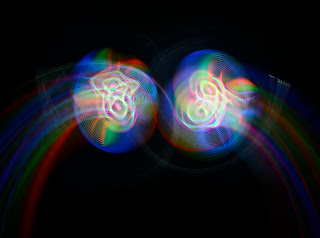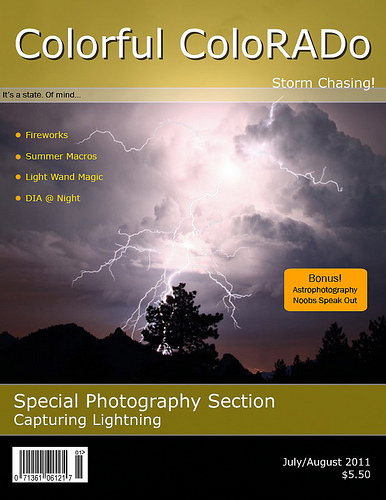 |
November/December 2011
|
December is one of my favorite months for light painting because everyone puts up a target to capture.
Simply taking a shot of Christmas lights doesn't qualify as a light painting, but there are lots of ways to manipulate static sources to create LPs. You can also add elements to existing lights such as was done in the magazine cover photo. In this case I both manipulated the tree LEDs by using a zoom and focal pull, then added the tinsel effect with glow sticks. Winter also gives more dark hours that are conducive to LPing. This year the extended family and neighbors set up a night sled run "Night riders," which resulted in some crazy trails. Permanent lights can also add to a scene nicely. Here on "Happy 2012," we have some creepy looking snowmen, actually a snowman and woman that had the benefit of being located close to an outdoor lit tree.
Spinning wool is something that is pretty well frowned upon in these parts, the fire danger is nothing to mess around with. You don't want to be the one that burned down a bunch of homes for a photograph. But when there is 3 feet of snow on the ground, we can relax a little. Maybe January will bring some spin outings. I have been dreaming up a massive spin taken from a high vantage point using a snow sculpture somehow. We'll see if mother nature dumps the crazy white stuff on us again.
Once every few years we get lucky enough to witness partial or even
better - full eclipses. I now own a filter that will allow shots of full
solar eclipses. The moon anyone can shoot without any extra gear. Of course longer lenses and telescopes make for the most dramatic
captures, but I've seen some really cool wide shots of eclipses with
interesting foregrounds as well.
This year we had a setting moon at dawn which presented some better opportunities for foregrounds. All I had was the continental divide but it added interest. The tough part here is getting detail on the darkened area of the moon without blowing out the lit area too badly. Its a tough balance, and there is no neutral density filter in the shape of a crescent that I know of. Cokin used to make gels that you could cut to any shape. Hmm, customizable ND sheets? I suppose you could hold a square filter up to take the edge off. In this case the moon had set before full eclipse was in view so there was no timing this any better. If you do have a full view of of the eclipse in its entirety, then the light conditions become much easier with the equally distributed earth glow. Make sure you don't lose the moon's position after the crescent is gone. It can be tough to find it in full shadow if you have lots of light pollution or a thin veil of clouds.
I have been interested in stencils for LPing for some time now and have created quite a few. This can be done using thin printed material or cutting out thicker stock where you want light to pass through. A more in-depth stenciling article coming soon. Smart phones are a great little light source and I've started playing around with using them as stencils. Here is a shot of the Planets app earth in 3D that I used against the night sky. The "stencil" I created was a piece of black construction paper a little larger than the phone case. A circular hole was cut in the size of the planet (which you can adjust using the zoom feature) to prevent the border ares from leaking through. With all the apps out there, not to mention even just using pictures, the smart phone may become my stencil of choice.
Shutter releases. How many have you lost? Been disappointed with? Broke? Were not willing to throw down the big bux on? Always needed more short-lasting obscure batteries? Yeah, me too. So actually this is not really a review but a few thoughts on what works for me and what doesn't. There are two categories roughly. Wired and wireless. I have owned them both. Plenty of each version. I can only speak for the Canon side but why every DSLR doesn't ship with a SR is a mystery to me. And while I'm venting, why stop at 30 seconds in manual mode? If you're going to include bulb mode then include the release. First, wireless remotes are great for starting and stopping the shot exactly when you want to if you are going to do work in the scene. Two things - they are easy to lose and the batteries are often not lasting very long and not standard. Wired remotes are easier to keep track of (I just Velcro mine to the tripod) but they require activation and deactivation at the camera. Not much better than using the mirror lockup, although you don't get any shake. These can be useful with extended features like an intervalometer. I recommend having both. I can give a slightly positive recommendation for
this wired unit (Amazon), but have not been completely satisfied with the wireless remotes I have tried. The best of all of them had a flash shoe mount receiver and a small release with an antennae. I almost always forgot to switch off the receiver and was always replacing the expensive and rare battery. If it could get its power from the camera instead, that would be a nice enhancement. If you have found a better mousetrap, please leave me a comment!






























